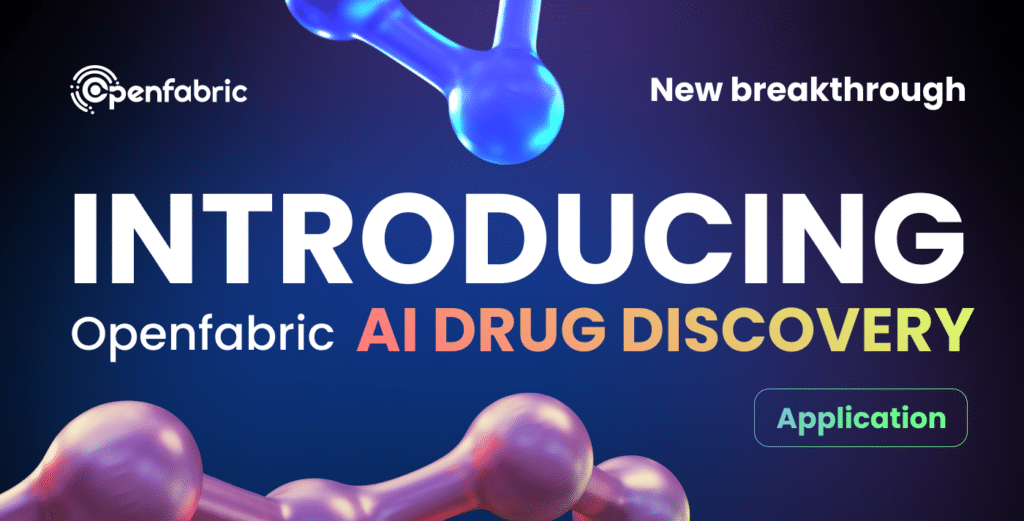
August 3, 2023 4 minutes read
New breakthrough: Introducing Openfabric AI Drug Discovery Application

Generative artificial intelligence (AI) has taken the world by storm in recent months, igniting debates about its potential impact on various aspects of society. AI systems like ChatGPT and Stable Diffusion have captured the imagination of the masses with their impressive and sometimes controversial ability to generate human-like text and artwork. It wasn’t soon enough; we officially unveiled some AI applications we have worked on since our inception in 2019.
Our utmost objective is to tickle some of the world’s pressing issues using artificial intelligence. These objectives come with commitment. That is why we are committed to solving real-world problems using Artificial Intelligence. It may surprise some that — in addition to some of the AI apps we have built (not to mention a few: Deep Fake, Trading Bot, Artfabric, Soundfabric, Stable diffusion, Generative AI), our most recent Drug Discovery AI application is also well underway in revolutionizing the Discovery of life-saving drugs.
Unraveling novel treatments for human diseases presents an immensely intricate challenge. Despite thorough research to comprehend the biological aspects of a disease, the quest for an effective therapeutic that can significantly enhance the quality of life remains. These high-throughput screens are often automated in sophisticated labs and are expensive to perform. Pre-clinical stages typically take three to six years, costing hundreds of millions to billions of dollars. However, Openfabric AI drug discovery tools are revolutionizing nearly every step of the drug discovery process, offering substantial potential to reshape the speed and economics of the industry.
Over the months, with joint efforts from our Research & Development and tech team led by our CEO, we have found a new breakthrough for the health industry. In discovering pharmaceuticals, scientists need to consider multiple factors that make a given chemical substance viable and have a deep understanding of how to synthesize and combine known substances to create novel ones.
Tackling this process is difficult, as the chemical nature of substances and the biological complexity of living organisms create a massive space of combinations and interactions that one cannot simply cover with one god-like AI model. Our Drug Discovery application utilizes several AI models to approach the drug discovery process, each specializing in a different part of it. As we mentioned above, the process is overwhelming and costly, which is precisely what prompted the use of AI to facilitate this field of science.
Drug Discovery Application aims to introduce tools that can help in the following areas of this scientific process:
- Novel molecule generation
- Toxicity prediction
- Drug-target interaction
Each task utilizes a different AI model, each trained individually on problem-specific datasets.
Novel molecule generation uses a model called Relational Graph Convolutional Network (RGCN) trained on a large dataset of drug-like molecules. Its goal is to try recreating a proper chemical molecule similar in construction to the drugs in the dataset, which could facilitate the search for analogs of known substances or the creation of entirely novel ones.
Toxicity prediction uses a Multi-Task Deep Neural Network to predict 13 toxicity indicators covering clinical toxicity and interference in biochemical pathways. This module aims to predict the probability of these indicators for a given chemical substance by analyzing its chemical structure.
Drug-target interaction is an essential task in the drug discovery process, in which researchers test the effects of a given chemical substance on protein targets in the human body. Using Drug Target Binding Affinity, we measure the strength of this interaction. The model was trained on a large dataset that covers over 25,000 pairs of drug-protein binding affinity scores. To make things easier, the application is connected to a protein database, allowing users to predict the strength of interaction simply by passing the index of a given protein and a chemical molecule.
Finally, if current trends persist, the era will arrive where drugs are no longer exclusively designed by humans, but instead, machines will play a pivotal role in the process. The vast potential of AI-enabled drug discovery to reduce costs and accelerate development timelines holds the key to increased drug accessibility and breakthroughs in treating currently incurable conditions.
However, this revolutionary advancement also ushers in a myriad of complex and unresolved issues. Matters such as intellectual property rights, the risk of technological misuse, and ensuring drug safety and efficacy in this new age demand careful consideration and practical solutions.
Because of the complexity of each task and probabilistic nature of generative models, users should treat the generated outputs with caution. What is more, currently present models are limited to the datasets they were trained on.

